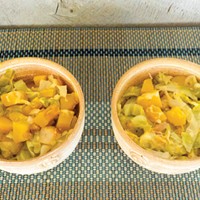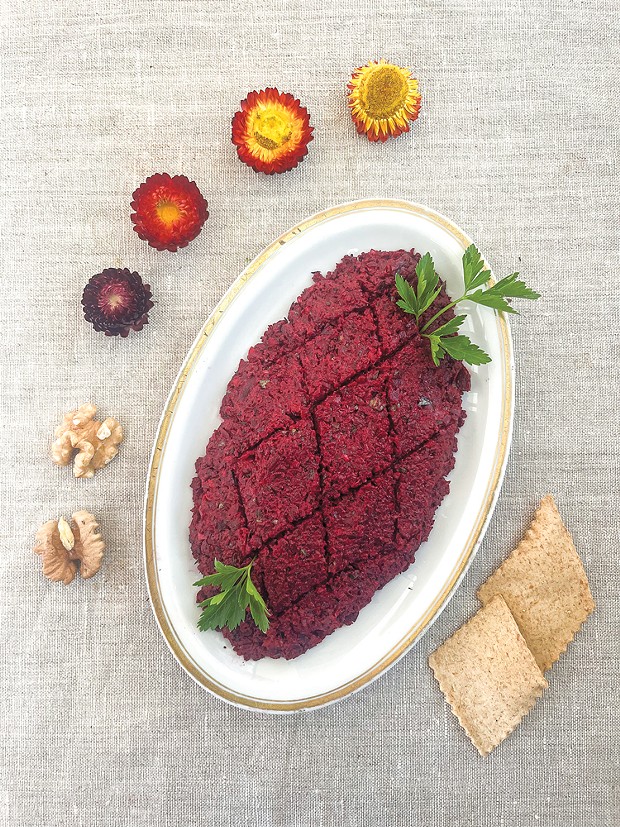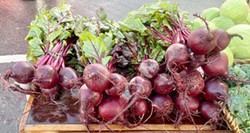[
{
"name": "Top Stories Video Pair",
"insertPoint": "7",
"component": "17087298",
"parentWrapperClass": "fdn-ads-inline-content-block",
"requiredCountToDisplay": "1"
}
]
It's January and "Eat more vegetables" is in the air.
There are variations, of course. Fruits are mentioned as well, the Mediterranean diet makes frequent appearances, the gut microbiome may also be invoked. The core message from many voices remains the same: Eat more vegetables.
The path to implementing that resonant piece of advice must be personalized, since what worked for me won't necessarily be effective for other people. Rather than additional advice, here are a few ideas that may be helpful in inspiring you in the months to come. The overarching idea is to make eating more vegetables joyful.
Choose new. Unleash your curiosity and try a new vegetable or a new way of preparing a vegetable you like. If you select a new-to-you vegetable at the farmers market, ask the farmer how they prepare it.
Choose variety. Alternate vegetables to avoid boredom. Along the same lines, try pairing vegetables to create a novel flavor and texture combination.
Choose color. Purple, orange, yellow and red vegetables cheer us during the gray season. And those rich hues mean phytonutrients, good-for-you compounds.
Let's start today with a deeply colorful vegetable: red beet, a root vegetable packed with flavor and rich in nutrients (vitamins, minerals, antioxidants) and fiber.
Red beets can be purchased loose or in bunches. In the latter case, you get their greens, which are quite tasty and nutritious. I like to cook various leafy greens mixed together (choose variety!). But that is a story for another day.
Some time ago, I came across pkhali, a dish from Georgia, the country in the Caucasus region. Pkhali is made from a finely chopped cooked vegetable (like spinach, eggplants, or beets) with a dressing of ground walnuts, garlic, vinegar, spices and herbs. As an additional incentive to try this recipe, note that walnuts (and nuts in general) are a component of the Mediterranean diet.
In beet pkhali, the vinegar and spices balance out the distinctive sweetness of red beets, and the walnuts provide a light body to the soft texture of cooked beets. The result is a colorful, delightful way of serving this nutritious root vegetable. Pkhali is served as a pâté. I've also read it defined as a spreadable salad — how's that for choosing new?
Here is my version of the recipe from Please to the Table: The Russian Cookbook by Anya von Bremzen and John Welchman (published in 1990), a rich collection of recipes from a large area spanning from the Baltic countries to Uzbekistan (the section on pkhali can be viewed on Google Books). As usual, I personalized the recipe, making some adjustments and settling on the version I am sharing.
The headnote says that pkhali must be made "at least 6 to 8 hours ahead for the flavor of the garlic to settle properly." I agree; this is a dish that profits from having its ingredients spend some time together before being enjoyed.
Red Beet Pkhali
If you purchase red beets with their greens, cut off the greens about 1 inch from the beet and consume them like you would other types of dark leafy greens. Consider roasting more beets than you need for the recipe, then add the extra to a soup or a green salad. Serves 4 as an appetizer.
Ingredients:
2 red beets or 8-9 ounces (6 ounces cooked and peeled)
For the walnut sauce:
1 ½ ounces walnuts, preferably freshly shelled
2 small garlic cloves, minced
1 tablespoon minced shallot or red spring onion
1 ½ tablespoons finely chopped fresh flat-leafed parsley
1/8 teaspoon ground coriander
1/8 teaspoon ground fenugreek
1 small pinch cayenne pepper
1/8 teaspoon fine sea salt
1 ½ tablespoons water
¾ tablespoon sherry vinegar or red wine vinegar
Additionally:
½ tablespoon sherry vinegar or red wine vinegar
1 tablespoon finely chopped fresh flat-leafed parsley
Fine sea salt, if needed, to taste
Heat the oven to 375 F. Scrub the beets well. Wrap each beet in foil and place on a baking sheet. Put the beets in the oven and roast them until easily pierced with a blade, about 1 hour.
Let the beets cool until easy to handle, then slip off the skin. Weigh out 6 ounces, cut the beets in bite-sized pieces and set them aside.
To make the walnut sauce, distribute the walnuts on an unlined baking sheet or cookie sheet and place in the oven heated to 350 F. Toast the walnuts for 5 minutes, until they become fragrant. Transfer them onto a plate and let them cool.
Grind the walnuts in a food processor. Place the ground walnuts in a bowl and add all the other sauce ingredients. Mix well and set aside.
Coarsely mince the roasted red beets in a food processor. Add the beets to the bowl with the walnut sauce. Mix well with a fork.
Add the additional vinegar, parsley and salt to taste, and mix well. Cover the bowl and refrigerate for several hours (6 to 8 recommended).
Take the pkhali out of the refrigerator ahead of time, spread it on a serving plate and smooth the top with a spatula. (I shaped it more like a low mound.) With a knife, make a pattern of diamonds on the top.
Serve at room temperature.
Simona Carini (she/her) also writes about her adventures in the kitchen on her blog www.pulcetta.com and shares photographs on Instagram @simonacarini. She particularly likes to create still lives with produce from the farmers market.
Speaking of...
-

Mexican and Masala
Feb 29, 2024 -

I'll Have My Spinach with Cheese and Chocolate, Please
May 11, 2023 -

Cooking While Traveling
Oct 21, 2021 - More »
more from the author
-
A Green Dish for Earth Day or Any Day
- Apr 18, 2024
-
A Daily Dose of Awe
- Jan 4, 2024
-
Classic Oatmeal Cookies Revisited
- Dec 28, 2023
- More »

































